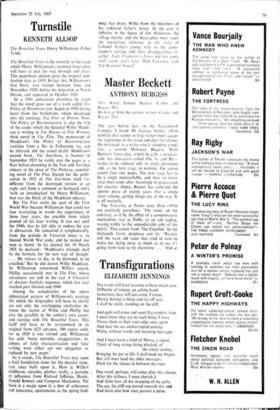Turnstile
KENNETH ALLSOP
The Beautiful Years Henry Williamson (Faber 7s 6d) The Beautiful Years is the turnstile to the mate which Henry Williamson's eventual biographer will have to pick his way through and chart. This paperback edition gives the original pub- lication date as 1919. In fact this, Williamson's first book, was written between June and November 1920, before his migration to North Devon, and appeared in October 1921.
In a 1941 annotation elsewhere he states, that the novel grew out of a work called The Policy of Reconstruction, begun in 1918 during leave from the battlefront, which developed into the tetralogy The Flax of Dream. Now The Policy of Reconstruction is also the ti:le of the credo which the fictional Willie Maddi- son is writing in The Dream of Fair Women, third novel in The Flax. The manuscript of Maddison's The Policy of Reconstruction vanishes from a flat in Folkestone (as, can be inferred, did the actual draft). Maddison's second book, The Star-born, is burned—in September 1923 he vainly uses the pages as a flare before drowning in the Taw and Torridge estuary at the close of The Pathway, conclud- ing novel of The Flax. Except for the publi- cation in 1932 of The Star-born itself ('as different from the destroyed version as an eagle owl from a common or barnyard owl'), 'with an introduction' by Henry Williamson, that was the finish of the Maddison odyssey.
But The Flax omits the span of the First World War because Williamson then could not face re-creating in words the experiences of those four years, the crucible from which poured all his later writing. It was not until the 1940s that he felt able to endure the war in abreaction. He conceived it symphonically, from the prelude in Victorian times to its Second World War coda, and he needed one man as theme. In his journal for 14 March 1921 he declared: 'Maddison's triumph shall be the formula for the new way of thought. . . . He refuses to die, to be drowned, to be crucified.' But he did drown Willie Maddison. So Williamson remustered Willie's cousin, Phillip, occasionally met in The Flax, whose adventures are told in the vast A Chronicle of Ancient Sunlight sequence, which last year reached part thirteen and 1940.
Among the complexities of the above abbreviated pattern of Williamson's working life which the biographer will have to clarify are not only the overlapping similarities be- tween the stories of Willie and Phillip but also the parallels in the author's own career, and starting with The Beautiful Years. This itself will have to be re-examined in its original form (£25 advance; 500 copies sold), for in 1929 it was revised and, Williamson has said, 'many untruths, exaggerations, in- cidents of false characterisation and false writing were either cut out altogether or replaced by new pages.'
As it stands, The Beautiful Years may seem a frail foundation stone for the massive struc- ture since built upon it. Here is Willie's childhood, episodic, plotless really, a pastiche of influences from Richard Jefferies, Hardy, Arnold Bennett and Compton. Mackenzie. Yet there is a magic upon it, a dew of artlessness and innocence, spontaneous as the spring bird- song that draWS Willie from the bleakness of his widowed father's house. In the cast is Jefteries in the figure of Jim Holloman. the village mystic; and the biographer must study the mysterious reference to the visits of Colonel Tetley's young wife to the game- keeper's cottage and their disappearance to- eether. Lady Chatterley's Lover did not come until seven years later. Had Laurence read The Beautiful Years?






























 Previous page
Previous page